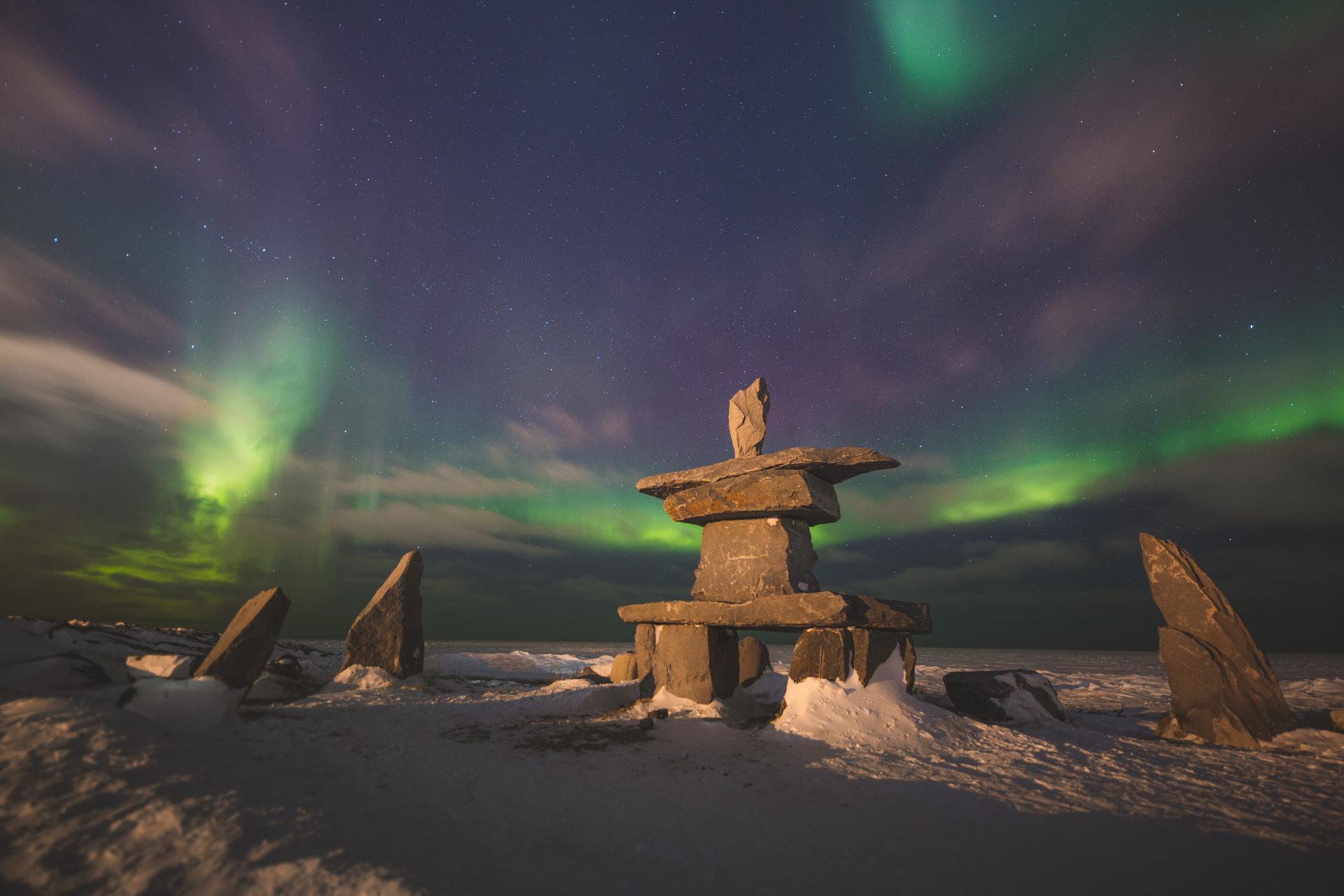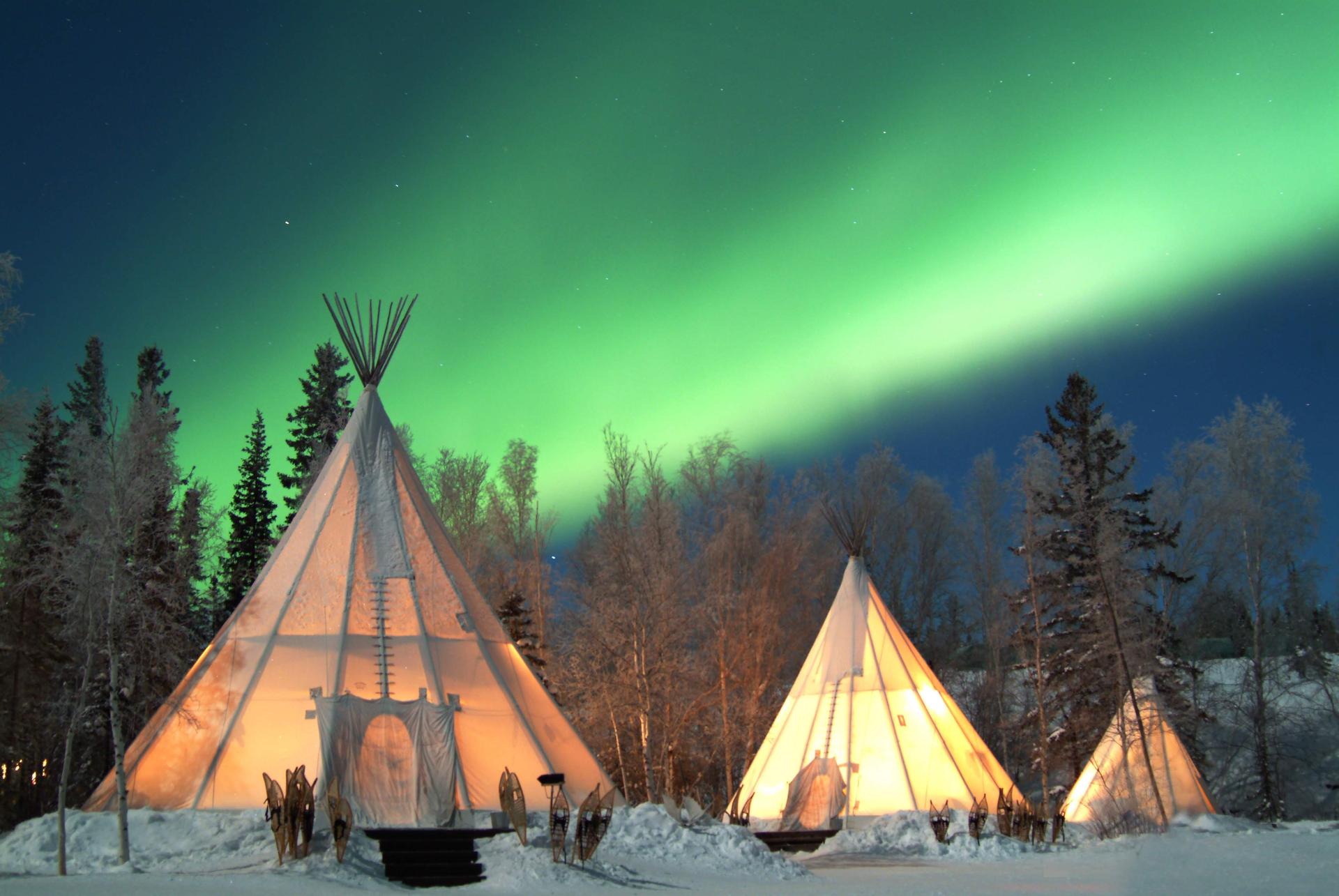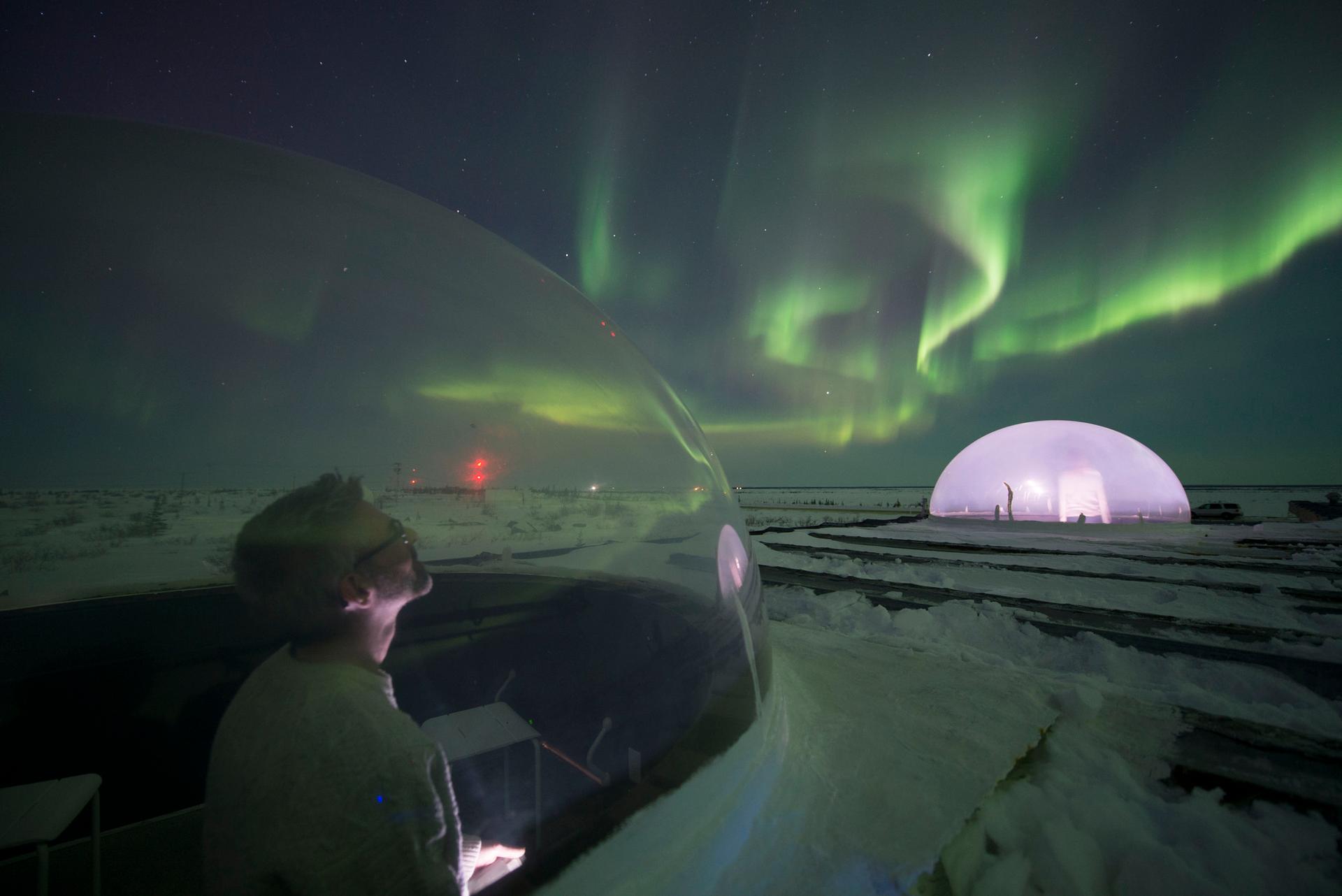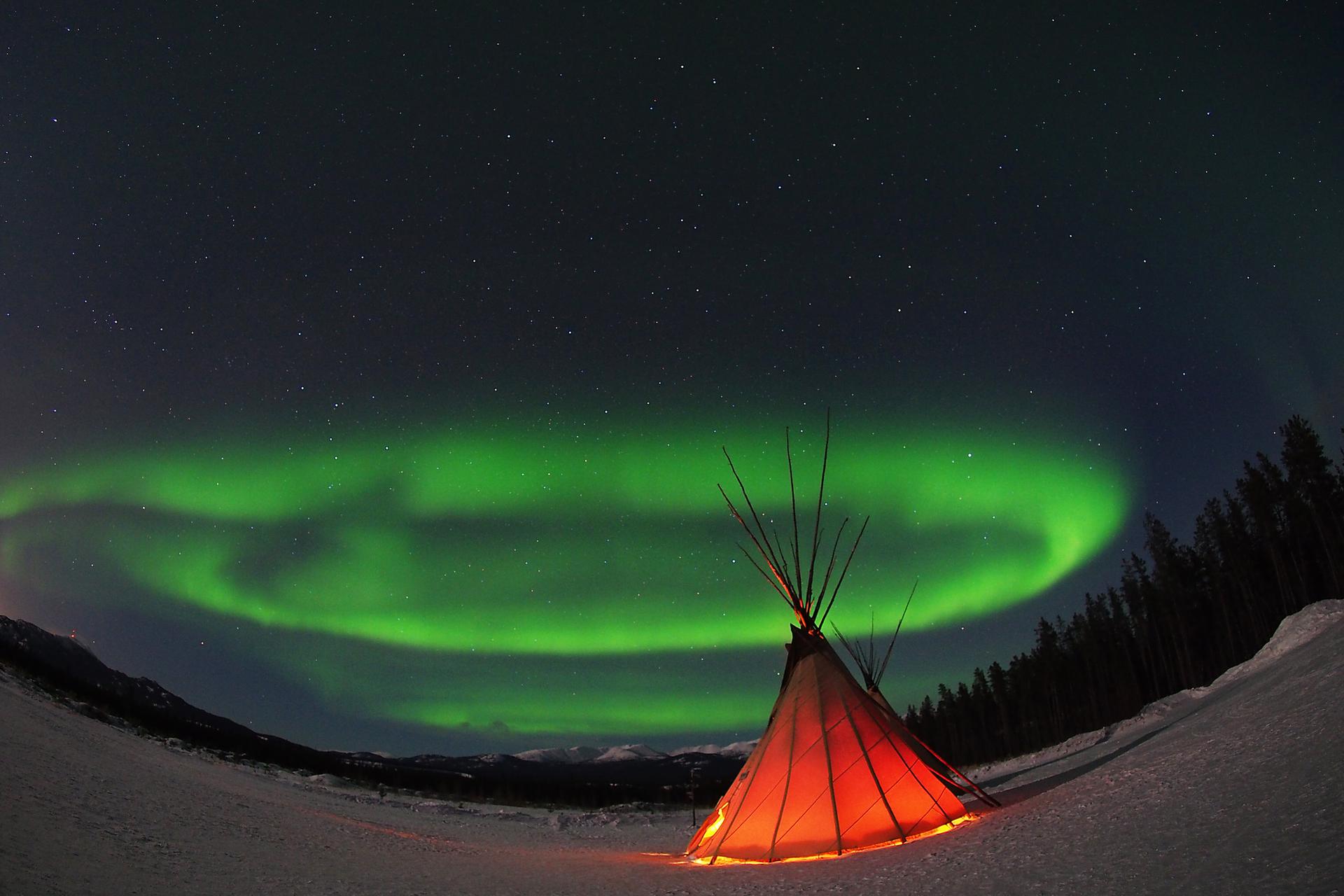The aurora borealis has all the characteristics of an ingénue: Elusive, gorgeous, often plays hard to get. Also known as the Northern Lights, this natural phenomenon is so stunning and ethereal, people travel from across the globe for a chance to catch a glimpse of it.
Here’s your guide to the very best places to see the aurora borealis across Canada, how and when to catch a show, and tips on making the most of the experience — whether it’s from a cushy viewing capsule in a Northwest Territories teepee village or just outside a remote wilderness cabin in the Yukon.
What causes it?

Inukshuk under the northern lights in Manitoba - Credit: Travel Manitoba
The aurora borealis effect happens in the Northern Hemisphere when the sun’s electrically charged particles, riding on a solar wind, enter the Earth’s atmosphere and collide with gases — namely oxygen and nitrogen. When the sun is at its most active is when you're most likely to catch a spectacular display. The name comes from Aurora, the Roman goddess of dawn, and Boreas, the Greek god of the north wind. Much of Canada’s North lies beneath the Northern Hemisphere’s Auroral Oval, a hot spot for activity.
Why is it so special?
First of all, aurora borealis is elusive — which makes it all the more attractive. It’s an awe-inspiring natural phenomenon and there’s no guarantee of a show. That said, chances are good, especially in the North near the magnetic pole. The effect makes for fantastical hues, though the Lights can take all kinds of forms — from arcs and rippling curtains, to misty wisps and translucent clouds. Sometimes it’s an eerie green, sometimes it’s shimmering purples, pinks, and yellows. Green is the most common, while red is rare. The colors zig, zag, and move surprisingly quickly — some say, “dance” — across the inky, night sky.
Where and when is it seen?
It's possible to see the Lights (almost) anywhere in Canada during all four seasons. But the North is the best place to see them, where they are the most active, most of the time. And the best venues are remote communities with little or no light pollution. You can't see the Lights through the clouds, so if you're near the coast -- say in British Columbia -- steer clear of coastal clouds and head north. After that, you want to seek out higher ground. Winter (December to March) is often the luckiest season, thanks to more hours of darkness each day and frequent cold, clear nights. The best time? Around midnight: 10 pm to 2 am is the window, so get ready to stay up late. Though you may be able to see them in any Canadian city or province (if you're lucky!) the following are the best spots for a sighting.
Northwest Territories
Winter, spring, and autumn

Aurora Village in the Northwest Territories
The very best place to see aurora borealis in Canada -- if not the world -- is the Northwest Territories, where they're generally visible 240 nights a year. The optimal timeframe is either fall or winter (though summer is pretty good, too).
Winter - The Lights are especially dramatic in winter, contrasted against a frozen, white wonderland. The most convenient way to take in the show is in cozy comfort at Aurora Village, a teepee village just outside Yellowknife. Specially designed for aurora observation, the place is equipped with spacious wood-stove heated teepees, fur-lined sofas, and warmed viewing capsules that recline.
Spring and Fall - These transitional seasons offer a unique opportunity to witness the aurora borealis in a different light. While winter provides a dramatic backdrop against a frozen wonderland, spring and fall offer milder temperatures and a vibrant shift in the surrounding landscapes. The dancing lights of the aurora against the backdrop of budding flora in spring or the rich tapestry of foliage in fall create a mesmerizing spectacle.
Manitoba
Autumn and winter

Churchill, Manitoba – Credit: Alex de Vries
Northern Manitoba is in the sub-Arctic Circle bordering Hudson Bay. Up here, you'll find Churchill, which bills itself as "one of the top three places on the planet" to see the Lights.. In fact, scientists from around the globe flock to the town of 850, famed for polar bears, to study the aurora. But the thing that makes a visit even more special is that you can combine it with bucket list wildlife viewing -- think belugas, polar bears, Arctic foxes, and more. Via Winnipeg is the best route, pausing at the Manitoba Museum to learn more about the Lights and how best to photograph them.
Late winter - Aurora high season in Churchill is February and March because of the extreme cold, which can drop to 40 below zero. Go with experienced operator Frontiers North, heading out around midnight in a heated Tundra Buggy kitted out with a bar. Pack extra batteries, which can fizzle in the plunging temps, and rent clothing from the Polar Inn & Suites. Snap pics of the often explosive display or better yet, just take it in so you don't miss a thing.
Fall - September to November is the second-best time to catch the Aurora. Combine trophy fishing until mid September with a lights show from the comfy deck at Aikens Lake Wilderness Lodge, a two-hour flight from Winnipeg.
Yukon
Autumn, winter, and spring

Combine aurora viewing, wildlife, and hot springs in Whitehorse – Credit: Arctic Range Adventure
Since the Gold Rush days, the Wild West Yukon has been the spot for fabled adventure. Dabble in a few of them -- dogsledding, fat biking, roughing it out in the open prospector-style -- and catch the Lights while you're there from September to April. In summer the night sky is not dark enough, thanks to the Midnight Sun, though this is also a great reason to visit!
Autumn - Take up residence in a prospector-style tent camp in the wilderness near Whitehorse with Northern Tales, lit only by the stars -- and the aurora. The outfitter provides modern creature comforts like barrel stoves and steaming beverages to keep you warm while you wait.
Late winter and early spring - In winter, Northern Tales hosts a variety of aurora packages and tours with activities such as snowshoeing, ice fishing, snowmobiling, and dog mushing. Cozy up in Arctic Range Adventures' AuroraCentre with your choice of a plush, insulated yurt or cozy First Nations-style teepee. Add wildlife viewing, dogsledding, and a soak in the Eclipse Nordic Hot Springs to round out the fun. Mountain biking pros Boréale Explorers lead guided snow biking-aurora packages, as well as snowmobiling or dogsledding-aurora combos out of their stylish eco-lodge and Yurtville basecamp near Whitehorse.
Even the most jaded can't help but be affected by the moving spectacle of the aurora -- as fleeting as it is mesmerizing and dazzling. Time to plan your trip.